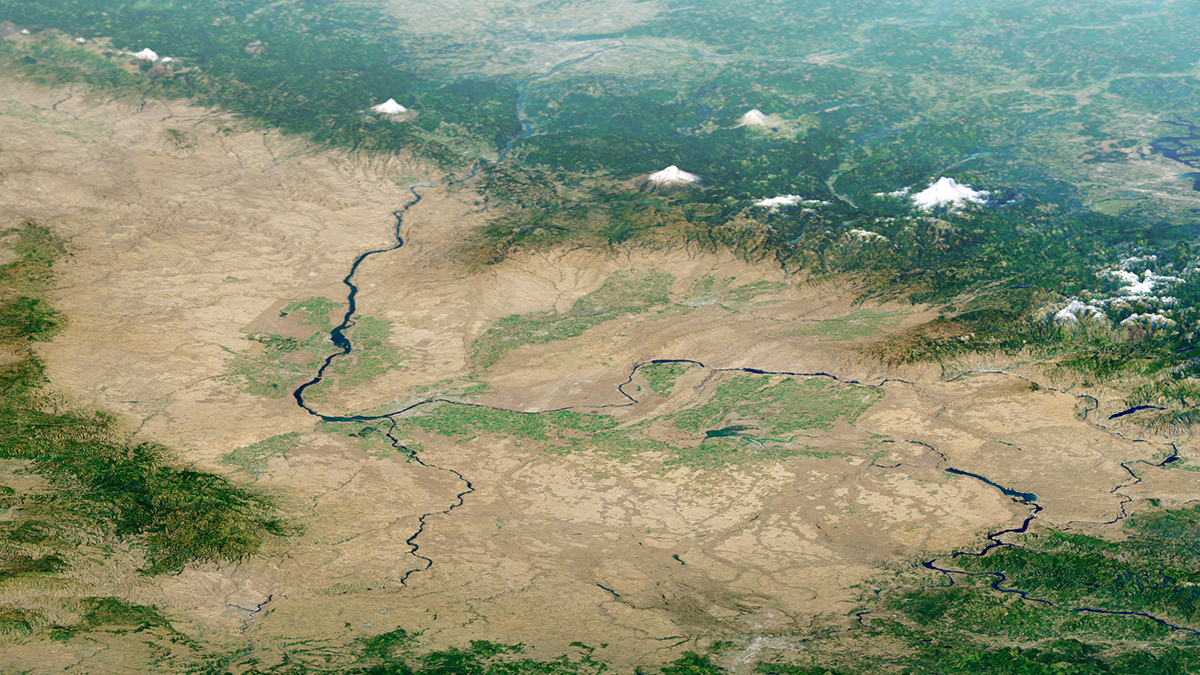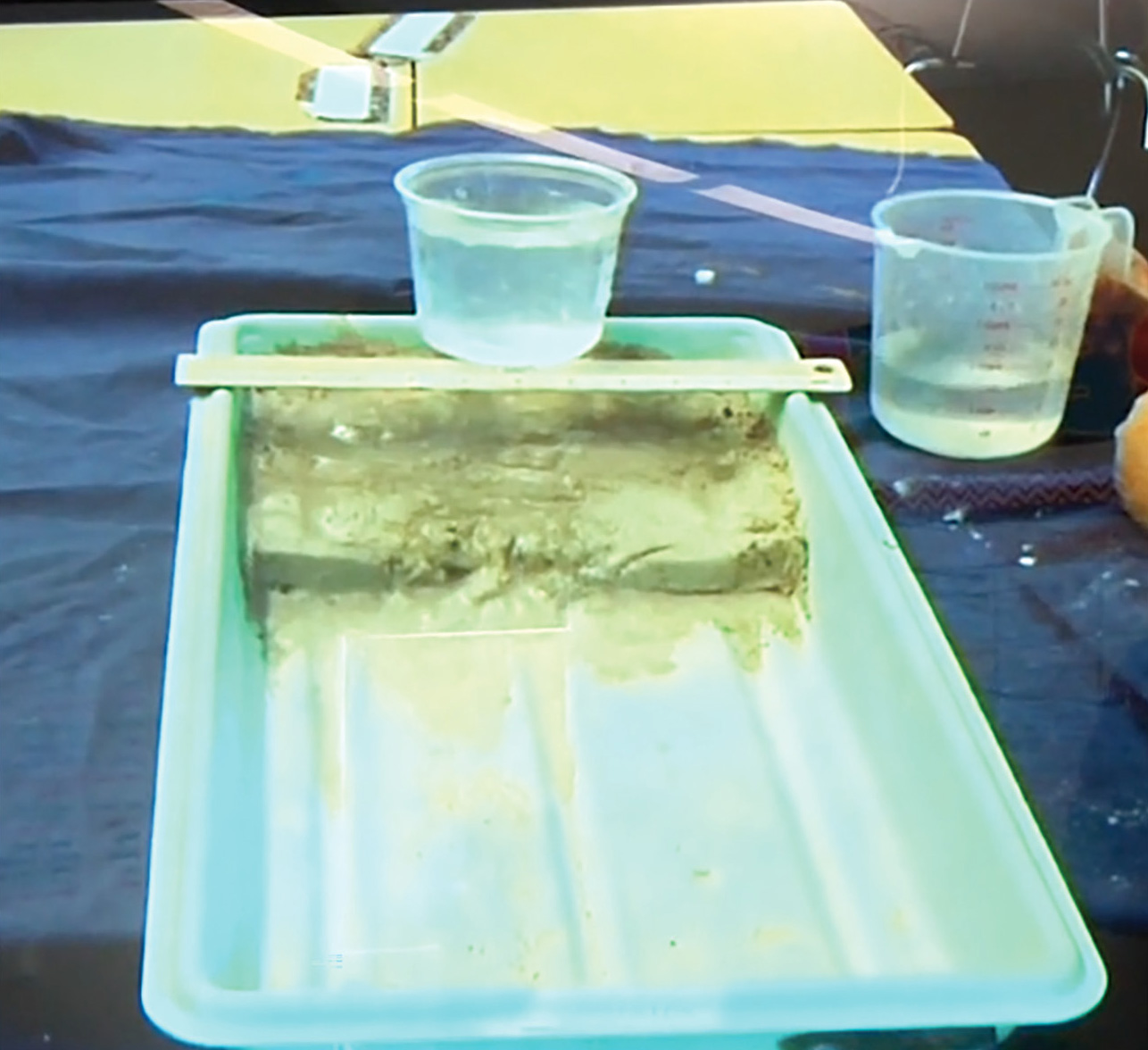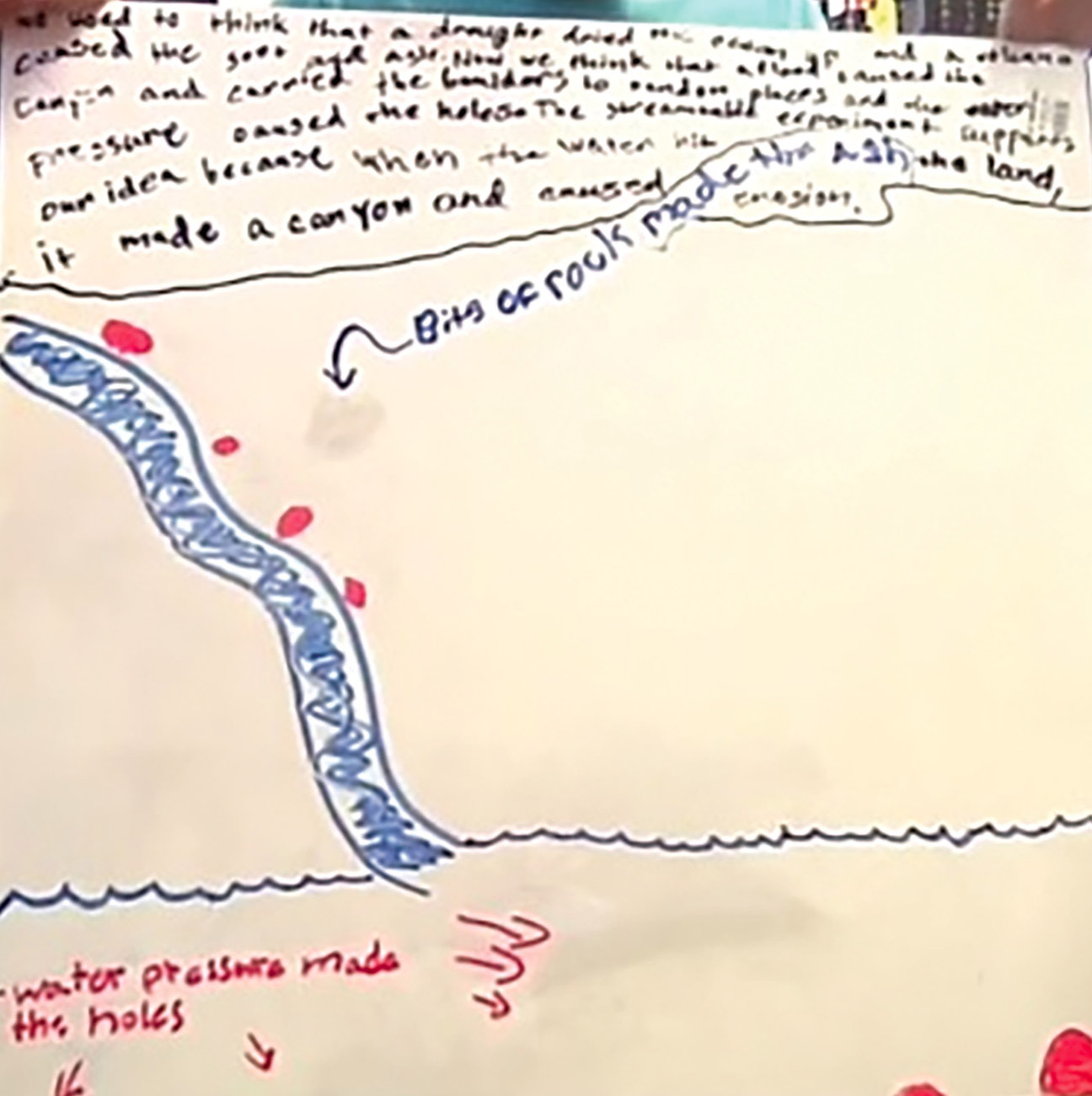cross-curricular connections
Science and Language Shifts in a Diverse Fourth-Grade Classroom
Science and Children—September/October 2021 (Volume 59, Issue 1)
By Alison Haas, Jennifer Whitten, and Carol Biskupic Knight

The Channeled Scablands, a breathtakingly vast and barren landscape in Washington, was mysteriously created over 15,000 years ago. In the early 19th century, it was widely accepted that the Channeled Scablands were formed by common geologic processes acting over a long period of time. In 1928, a rebel geologist, Harlen Bretz, proposed a seemingly outlandish theory that the landscape was formed by a catastrophic event thousands of years earlier. Bretz’s theory sparked intense debate lasting nearly four decades and became the subject of one of the most well-known controversies in the history of Earth science. Who can help solve the elusive mystery of how the Channeled Scablands were formed?
Enter Ms. Whitten’s fourth-grade class, a group of linguistically diverse students eager to figure out what caused the Scablands. Her classroom is a space where all learners, including English learners (ELs), engage meaningfully in classroom discourse—a space where science is not being memorized but experienced by captivated students. This article presents science and language instructional shifts grounded in the Next Generation Science Standards (NGSS) and contemporary thinking in second language acquisition, respectively. We describe how science and language instructional shifts support each other for ELs. Then, we illustrate these shifts using Ms. Whitten’s unit on the Channeled Scablands. A video of the vignette can be accessed at https://www.youtube.com/watch?v=wmyg7XS6Erc.
Science Instructional Shifts
Science Shift 1—Focus on phenomena and design solutions to problems
While traditional approaches have students learn science as a body of knowledge, the NGSS focus on explaining phenomena and designing solutions to problems. Phenomena and problems should be real and relevant to students, positioning them as agents of their own learning.
Science Shift 2—Three-dimensional learning
The NGSS, written as performance expectations (PEs), seamlessly blend scientific and engineering practices (SEPs), crosscutting concepts (CCCs), and disciplinary core ideas (DCIs). Through three-dimensional learning, students “do” science and engineering.
Science Shift 3—Coherence of student understanding
Students develop deeper and more sophisticated understanding of science over the course of a lesson, unit, year, and K–12 schooling. Each lesson builds on previous lessons, and new understandings lead to new questions to investigate.
Language Instructional Shifts
Language Shift 1—Language use for purposeful communication
The NGSS offer rich opportunities for students to do things with language. By anchoring learning in phenomena, teachers provide students with a reason to communicate and a compelling context to express ideas. The teacher’s role is not to “teach” language but to “instigate” opportunities for purposeful communication that are supportive of both science and language learning (Walqui and vanLier 2010).
Language Shift 2—Meaningful participation of all students, including ELs with less-than-perfect English
ELs are capable of engaging in cognitively demanding tasks despite needing varying degrees of support to demonstrate what they know and can do. Their contributions should be valued for the merit of ideas rather than linguistic accuracy (Lee, Quinn, and Valdés 2013). ELs also bring to the science classroom a vast array of cultural and community resources that help them make sense of the natural and designed world (González, Moll, and Amanti 2005).
Language Shift 3—Use of a range of registers and modalities
In the NGSS classroom, students use a range of registers (i.e., ways of using language), from everyday/colloquial to specialized/disciplinary, to communicate ideas and emerging understandings. They also draw on multiple modalities (e.g., symbols, graphs, tables) that are essential in science disciplines.
Classroom Vignette
To illustrate how these instructional shifts provide a rich environment for both science and language learning with ELs, we present Ms. Whitten’s two-week unit about the Channeled Scablands as an exemplar vignette. Throughout the vignette, we use brackets to highlight when science instructional shifts and language instructional shifts are most salient.
Because the Scablands are located in a neighboring state and students are interested in learning about their origins, Ms. Whitten decides to make the mystery of how the Scablands were formed the unit’s anchoring phenomenon [Science Shift 1: The unit focuses on a local, community-based phenomenon.] Before launching the unit, Ms. Whitten intentionally groups students. First, she assigns students to “investigation groups” of four or five students who complete all investigations together throughout the unit. Second, she assigns students to “talk partners” of two or three students who also remain throughout the unit. In assigning students to groups, Ms. Whitten takes special consideration of ELs by placing them with group members who speak their home language.
The unit addresses NGSS PE 4-ESS2-1. It launches with a video about the Scablands, which depicts images of the Washington landscape (http://www.pbs.org/wgbh/nova/megaflood/scab-nf.html). Ms. Whitten stops the video just before the mystery is revealed and asks students what they observed and what questions they have about the landscape. With their talk partners, students discuss observations, record questions on sticky notes, and then place those sticky notes on a classroom bulletin board. [Language Shift 2: All student questions are important. Focus is on merit of ideas, not linguistic accuracy.] The class organizes the questions into different categories to form the “Driving Question (DQ) board.” The DQ board, a physical bulletin board containing sticky notes with student questions, is continually evolving over the course of the unit with questions being added and rearranged as students figure out answers. After posting questions about the Scablands to the DQ board, the class comes to a consensus that all questions relate to one larger question: How were the Scablands formed? This question becomes the unit’s DQ. Throughout this process, Ms. Whitten uses student questions as an informal assessment to gauge their prior knowledge.
Over the course of the two weeks, students carry out three classroom investigations with their investigation groups to answer the DQ. The first investigation examines what happens when rocks are exposed to water. Following guidance from Ms. Whitten, students place chalklike rocks into a jar and shake the jar for three minutes. Students observe and record the size of the rocks before and after shaking. They observe that some rocks have worn away. Students then add water to the jar and shake the jar for another three minutes. They observe that water makes the rocks wear away faster, which Ms. Whitten identifies as an example of erosion. [Language Shift 1: “Erosion” is introduced when it is useful to further the discourse. Focus is on purposeful communication, not discrete bits of language.]
Based on evidence from the investigation, each investigation group uses markers and whiteboards to develop an initial model of how the Scablands were formed. [Science Shift 2: Students develop models [SEP] to represent how water causes [CCC] erosion [DCI].] These models are foundational to the unit, as they represent students’ current thinking and will be revised as new evidence is collected and new understandings emerge. Ms. Whitten uses students’ initial models for formative assessment to provide feedback and guide subsequent instruction. While working with each investigation group, she uses a self-created rubric (https://tinyurl.com/rffw5j56) that identifies criteria for the three dimensions of science learning. Using this rubric, she assesses the strengths and weaknesses of each model, probes student thinking, and keeps notes on the group discussion.
Once students develop their initial group models, Ms. Whitten convenes a “board meeting” where students share their models, ask clarifying questions of other groups, and argue based on evidence for their explanations of the phenomenon. Camila, a recently arrived student from Honduras, shares her group model with the class:
Camila: (pointing to the model) Lot of water. Rocks get smaller.
Ms. Whitten: Interesting. So, Camila’s model shows how water wore down, or eroded, the rocks in the Scablands. It passed over the rocks again and again and again (gesturing with her hands) and made the rocks smaller. It eroded the rocks. What does everybody else think? Did other groups also include that in their models? [Language Shift 2: Despite less-than-perfect English, Camila participates meaningfully and demonstrates understanding. Ms. Whitten amplifies, rather than simplifies, her language when responding to Camila.]
As the discussion continues, the class agrees that water is powerful enough to shape the landscape, but more evidence is needed to figure out how the Scablands were formed.
Over the next week, students engage in the second and third investigations to examine the erosive effects of water. While the procedures for the first investigation were mostly determined in advance, Ms. Whitten asks students to take a more active role in planning and carrying out these two follow-up investigations. [Science Shift 3: Students build understanding over time. Before, all investigation procedures were provided. Now, students assume greater responsibility in planning and carrying out an investigation.] After each investigation (described next), students revise their group models based on new evidence. Ms. Whitten uses each revised model as formative assessment to gauge the progression of student understanding over time.
For the second investigation, students build stream tables to test whether the angle of the table affects the rate of erosion as water is poured onto the table. Students identify variables to control (e.g., amount of sand, amount of water) and then test how the angle of the table affects the amount of time it takes for a canyon to form. In their investigation groups, students pour water from a plastic measuring cup down a sand-filled pan (the stream table) at three different angles (Figure 1). While students use an investigation handout provided by the teacher for basic setup (e.g., placing the pan flat on the table and filling it with sand), they take initiative for specific procedures, such as how high to hold the water and how to arrange the sand.

Students record their observations and plot the data on graphs. [Language Shift 3: Students use multiple modalities, including data tables and graphs, to represent their thinking.] The graphs show that as the angle of the table increases, the canyon forms more quickly. Students conclude that elevating the angle of the table increases the speed of water traveling through the table and, thus, the rate of erosion. [Science Shift 2: Students engage in three-dimensional learning by planning an investigation [SEP] to provide evidence of how water can affect [CCC] the rate of erosion [DCI].]
The third investigation is motivated by the results of the second investigation. Students wonder what other factors, in addition to the angle of the table, might also affect the rate of erosion. [Science Shift 3: New understanding leads to new questions.] Some students notice that each group poured different amounts of water onto the table and that this might have affected the rate of erosion. The class agrees to investigate this question. Like the previous investigation, students ensure a fair test by holding all variables constant except the amount of water poured onto the table. In their investigation groups, students pour three different amounts of water from a plastic measuring cup into the stream table. They conclude that as the amount of water increases, the canyon forms more quickly (i.e., the rate of erosion increases).
Working with their talk partners, students use data from the second and third investigations to construct an argument with a claim, evidence, and reasoning about factors that affect the rate of erosion. After discussion with their talk partners, students write arguments individually to support the claim that increasing the angle of the table (second investigation) and the amount of water poured onto the table (third investigation) both increase the rate of erosion. Ms. Whitten uses a scoring rubric to assess the claim, evidence, and reasoning for individual arguments. She allows time for students to revise their arguments as needed.
After completing individual arguments, investigation groups come back together to develop final group models of the how the Scablands were formed (Figure 2). These models serve as the summative assessment of the unit to gauge students’ mastery of the three dimensions in the targeted PE (4-ESS2-1).

The following discussion takes place among students in one investigation group who were collaborating to develop their final group model:
Brian: Those holes are from those rocks, and then the water moved those rocks to a different area and then made multiple. That’s what I think. [Language Shift 3: An everyday register is used in small groups. A more specialized register might be necessary when students present to the whole class.]
Alonso: What do you think, Phuong?
Phuong: I go with Brian’s idea.
Alonso: Experiment 1 which, uh, most represents the landforms.
Brian: I think it was number 3 (investigation about the amount of water) because 3 added more water, and was like more efficient. Maybe there was more water than less water. I think 3 was more efficient because there was like a little delta, and the whole thing almost collapsed!
As a culminating activity, Ms. Whitten convenes another board meeting where each investigation group shares their final group model of how the Scablands were formed. Though group models are different, all models use evidence from the three investigations to show how a large amount of water moving at a rapid speed eroded the Scablands and carved wide, deep canyons in the landscape. During the board meeting, Chen presents his final group model to the class and responds to a follow-up question from a classmate:
Chen: We think that a flood caused the canyon and carried the boulders to random places . . . and the stream table experiment supports our ideas because when the water hit the land, it made a canyon and caused erosion.
Ms. Whitten: Any questions for this group?
Jasmine: How did the bits of rocks make the ash? [Language Shift 1: Jasmine uses language purposefully. The answer will help the class understand the phenomenon.]
Chen: The water chipped away bits of rock.
As the board meeting comes to a close, Ms. Whitten facilitates a class discussion highlighting commonalities across group models, which leads to the class consensus model that represents the collective understanding of the class. Overall, the class’s explanation is consistent with Bretz’s theory that a massive flood traveling at ferocious speeds caused the formation of the Scablands. Students finish watching the video from the beginning of the unit and are excited to learn that they, along with geologist Harlen Bretz, have solved the mystery of the Scablands. [Science Shift 1: Phenomenon gives a purpose to learning science. Students uncover important science ideas in the process of explaining the Scablands phenomenon.]
Conclusion
Learning science according to the vision of the NGSS is new. Learning language while it is being used to learn science is even newer. Successfully implementing these science and language instructional shifts is demanding and requires supports in the form of teacher professional development, science instructional time, and science supplies. Rather than implementing these shifts all at once, teachers can infuse them gradually into their instruction. While implementing these shifts is challenging, it is also rewarding and can help create a meaningful space for all students, including ELs, to engage in and make sense of science while also developing language.
Alison Haas (ams728@nyu.edu) is the Director of Development and Implementation for the SAIL-On project at New York University. Jennifer Whitten is a principal in Beaverton School District in Beaverton, Oregon. Carol Biskupic Knight is an elementary science education consultant and a fourth-grade teacher in Beaverton, Oregon.
Computer Science Disciplinary Core Ideas Multilingual Learners Environmental Science Interdisciplinary NGSS Pedagogy Performance Expectations Science and Engineering Practices Three-Dimensional Learning Elementary Grade 4


